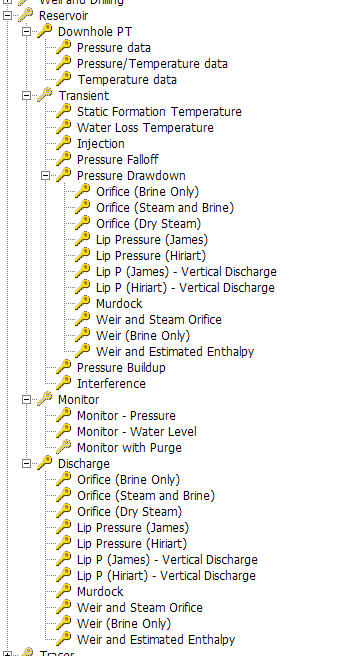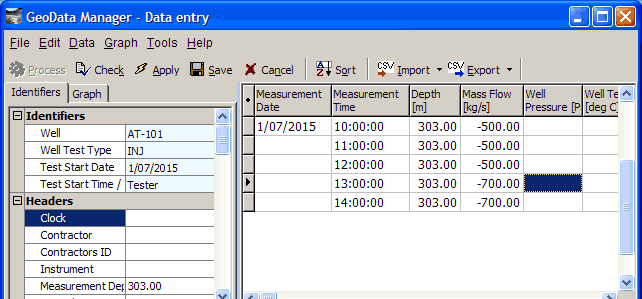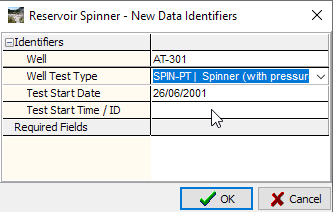
Introduction
Tutorials
Getting familiar with GeoData Manager
Changing how GeoData Manager looks
Scenarios for using GeoData Manager
Data types and nodes
Help with data types and nodes

Getting familiar with GeoData Manager
Changing how GeoData Manager looks
Scenarios for using GeoData Manager
Help with data types and nodes
These data types store temperature, pressure and flow measurements from wells.

Choose the correct data type to use, depending on the kind of data you want to enter or work with:
| For this kind of data | Choose this category or data type |
|---|---|
| Downhole (PT measurements at different depths) | Downhole PT |
| Spinner | Spinner |
| Joint PT and spinner runs | Downhole PT and Spinner |
| Transient (measurements at different times) | Transient |
| Monitor | Monitor |
| Discharge (when the well is discharged) | Discharge |
| Changes to capilliary tubing | Capilliary tubing events |
Data sets in Reservoir and Steamfield are in the same header table, and have the same kind of detail table. You can work with data sets of both types at either node: in the filter bar at either node, either select No Filter or enter appropriate Well Test Types.
When you enter Reservoir data and click Check , GeoData Manager can automatically fill in some fields:
Reservoir > Downhole PT
For Well Test Type: PRES (pressure only), PT (pressure/temperature), PT-S (pressure/temperature with simultaneous spinner data), TEMP (temperature only).
These measurements are down the length of the well and therefore precise date/time values are not needed. GeoData Manager automatically fills in these fields in the detail table if they are empty:
Measurement Date: filled with test start date.Measurement Time: filled with Test Start Time / ID if recorded as a time (hh:mm(:ss), otherwise with 00:00.Reservoir > Transient, Reservoir > Monitor and Reservoir > Discharge
For Well Test Type: DSCH (discharge), INJ (injection), INT (interference test), IWD (injection well daily record), MON (monitor record), PBU (pressure build-up), PDD (pressure drawdown), PFO (pressure fall-off), PWD (production well daily record), SFTT (static formation temperature test).
These measurements are made at a fixed location in the well over a period of time. If the depth in the detail table is empty, GeoData Manager automatically fills this with the depth from the header data.
For Well Test Type: WLTT (water loss temperature test) the temperature gauge is run up and down the well during injection to see if water loss zones can be detected. GeoData Manager does not automatically fill any fields because both depth and time are important.
Injection mass flow
The convention is that mass flow is negative for injection. If you enter positive mass flows, GeoData Manager will change them to negative.
For example
An injection test, before clicking Check:

After clicking Check:

Has downhole pressure and temperature measurements. There are three data types in the Downhole PT category:
| Kind of data | Data type to use |
|---|---|
| Pressure vs depth down the well | Pressure data |
| Simultaneous measurements of temperature and pressure vs depth down the well | Pressure/Temperature data |
| Temperature vs depth down the well | Temperature data |
You can work with all three data types at the node Downhole PT, but you can not create new data sets.
If you have a joint pressure, temperature and spinner run, see here.
Temperature measurements made during water loss tests are more appropriately entered as a Water Loss Temperature (WLTT) test.
If significant pressure changes are observed during the test then enter Wellhead pressure into the detail data, in the WHP column. Otherwise enter an average or typical value in the header, in Test WHP.
In the Depth field in the detail data, enter the measured depth from the wellhead, not the true vertical depth.
Choose a Well Status Type from the dropdown list:
| Well Status Type | Meaning |
|---|---|
| BLEED | Well on bleed. No flow assumptions |
| CONDENSATE | Injection of condensate into the well |
| Descarga | Well on discharge to atmosphere (vertical or to silencer) |
| INJECTION | Injection into well (either tests or reinjection well) |
| OPEN | Well open but no flow in or out of well |
| PRODUCTION | Well on discharge to production separator |
| SHUT IN | Well shut in. GeoData Manager automatically sets the mass flow to zero |
Spinner measurements record the flow of fluid within the well, and are a powerful method to find feed or loss zones within the well. You can enter spinner measurements either here, in Reservoir, or Downhole logging see here; the two places are equivalent.
GeoData Manager assumes that production mass flows are positive and injection flows are negative. Spinner runs are usually made while injecting. If you enter a positive mass flow, then when you click Check or Save, GeoData Manager asks if you want to change the sign to negative:

Spinner measurements are commonly made in the same run with temperature and pressure measurements. GeoData Manager stores spinner data separately from the PT data. It has options to simplify using joint PT and spinner measurements.
There are several multiple graphs to plot these measurements see here.
There are several common scenarios:
You have a spinner run with no P or T measurements: enter the spinner measurements at Reservoir > Spinner and choose Well Test Type to be SPIN.
You have a P, T or PT run with no spinner data: enter the measurements at Reservoir > Downhole PT and choose Well Test Type to be PRES, PT or TEMP as appropriate.
You have a run with joint spinner and PT data:
Enter the joint run's PT measurements in Reservoir > Downhole PT. Choose Well Test Type to be PT-S. GeoData Manager stores this run in the Well Events Summary.
Enter the joint run's spinner measurements in Reservoir > Spinner. Choose Well Test Type to be SPIN-PT and set Test Start Date and Test Start Time / ID the same as for the associated PT-S run. GeoData Manager does not store this run in the Well Events Summary.
You have several joint spinner and PT runs and only want to keep one set of PT measurements:
Enter the set of PT measurements in Reservoir > Downhole PT. Choose Well Test Type to be PT-S.
Enter each set of spinner measurements in Reservoir > Spinner. Choose Well Test Type to be SPIN-PT and set Test Start Date the same as for the associated PT-S run. Test Start Time / ID must be different for each spinner run; it is convenient to enter a different description for each spinner run, for example 10:45 SPIN-PT Run2 Up, 13:27 Run2 Down. GeoData Manager does not store these spinner runs in the Well Events Summary.
Spinner data is usually collected during a downhole PT run, using a combined Spinner-PT tool. While the first PT run is generally the most reliable and entered into GeoData Manager, a number of up and down runs are performed, and the spinner data from these runs is separately processed to obtain a smoothed spinner profile.
When entering the smoothed spinner data, it is useful to use the identifiers of the reliable PT run, so that spinner and PT data can be easily presented on a single plot on one of the Combined PT-Spinner multiple graphs see here.
To use this function, proceed as follows:
Reservoir > Spinner or the Downhole > Spinner node, right-click and select New.In the New Data Identifier box, select the well and set Well Test Type to SPIN-PT.

At Test Start Date, type in the date that the measurement was performed.
Then click in the Test Start Time / ID box. If there are one or more PT runs from the same well on the same date, with Well Test Type = PT-S, a list of Test Start Time / ID values will be shown.

Click on the appropriate Test Start Time / ID value, and click OK to proceed.
This category has pressure and temperature measurements:
For all tests, both transient pressure and temperature data can be entered if required, even though these tests, apart from SFTT and WLTT, are designed primarily to measure transient pressure behaviour.
it is usually best to set the start date and time to when the transient event started, rather than when the measurements started read more.
This test is carried out during an interruption in drilling to obtain an indication of formation temperature. It is a transient temperature test, composed of measurements of temperature vs time at a fixed depth in the well.
Test Start Date and Test Start Time correspond to the start of the temperature transient event, when the circulation of drilling fluid in the well stopped.
Test Event Duration, tp, is the time between when the drilling bit passed the instrument depth and when circulation stopped, i.e. the total time that the formation, at instrument depth, was exposed to circulating drilling fluids.
Previous Flow Temperature is the temperature of the circulating drilling fluid.
If significant pressure changes are observed during the test then enter Wellhead pressure into the detail data, in the WHP column. Otherwise enter an average or typical value in the header, in Test WHP.
The Water Loss Temperature Test (WLTT) consists of downhole temperature measurements at various depths while water is being injected into the well. Two different methods are currently in use - either regular downhole survey measurements which will show a temperature increase below the point at which the injected liquid enters the formation, or repeat measurements at a number of different depths up and down the well immediately after injection, to intercept the cold injection front and to measure its progress.
Although included in the transient test menu, a WLTT test has downhole test features as well. Test Start Time should be set at the beginning of injection, especially for the second WLTT method. It is also recommended that pre-injection temperatures at test start are entered to obtain a satisfactory graph.
Wellhead pressure values can be entered in the WHP column of the data table if significant changes have occurred during the test. Otherwise, an average or typical value in the Test WHP field in the header will suffice.
This test is one of the suite of well completion tests, carried out at the completion of drilling. Water is injected into the well at several constant injection rates, and downhole pressure is monitored to give the relationship of pressure vs injection flow. The increase of pressure at each injection rate can also be analysed as a pressure transient.
Each injection rate is entered as a separate injectivity test, with the Test Start Time corresponding to the commencement of that injection rate. This allows different instrument serial numbers to be entered for each test (important if the measurement instruments were changed), and also facilitates pressure transient analysis.
If significant pressure changes are observed during the test then enter Wellhead pressure into the detail data, in the WHP column. Otherwise enter an average or typical value in the header, in Test WHP.
For each data set, enter Measurement Depth and Test Mass Flow (negative to denote injection).
The pressure falloff test is a pressure transient test, carried out after a period of fluid injection into the well, such as after an injectivity test. Pressure measurements are usually made at depth, at the major feedzone in the well.
The new test Identifier window asks for Test Event Duration, tp and Previous Final Flow. Both these quantities must be entered if full analysis is to be carried out. The weighted injection time is defined as:
tp (s) = Total mass injected (kg) / Previous Final Flow (kg/s)
The earliest measured pressure in the data table is assumed to be steady-state value during injection, and differential pressures are calculated with respect to this value.
This node and its sub-nodes are for pressure drawdown tests on development wells.
For information and to choose the data type/node to use, see here.
The pressure buildup test is a pressure transient test, carried out after a period of well discharge. Pressure measurements are usually made at depth, at the major feedzone in the well. As for all transient tests, the Test Start Time is the beginning of the transient event, in this case the cessation of discharge. Note that measurements can occur before the test start time.
The new test Identifier window asks for Test Event Duration, tp and Previous Final Flow. Both these quantities must be entered if full analysis is to be carried out. The weighted injection time is defined as:
tp (s) = Total mass injected (kg) / Previous Final Flow (kg/s)
The earliest measured pressure in the data table is assumed to be steady-state value during discharge, and differential pressures are calculated with respect to this value.
The interference test can be considered a pressure transient test, with a Test Start Time corresponding to the opening or closing of a nearby well. Pressure measurements are often taken downhole, although wellhead pressure also provides a transient response.
The earliest measured pressure in the data table is assumed to be the stable pre-event pressure, and is used for differential pressure calculations.
This category has sub-nodes:
You can work with all three data types at the node Monitor, but you can not create new data sets.
This node and its sub-nodes are for discharge tests on development wells.
For information and to choose the data type/node to use, follow this link.
This node is to record changes to capilliary tubing systems.
Note:
Before you enter a capilliary tubing event, enter lookup data:
In LOOKUPS > Reservoir > Cap Tubing Event, enter the tubing actions you want to record, for example: install, purge, remove.
In LOOKUPS > Reservoir > Cap Tubing Details, enter the tubing details you want to record, for example: tubing size and material.
Record pressure measured by the capilliary tubing at the Monitor node above.